Top Story: Arts
The Rock is a wrap—for now
March 10, 2012
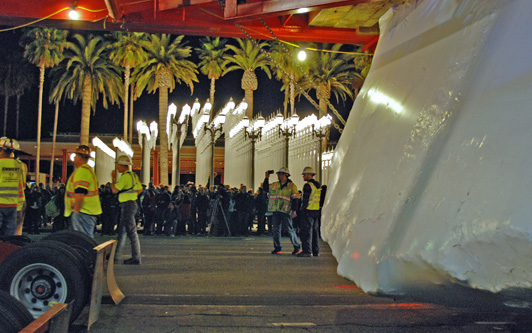
After its 4:30 a.m arrival, The Rock was parked for a photo-op in front of Chris Burden's iconic "Urban Light."
As crowds cheered and a loudspeaker blared Queen’s “We Will Rock You,” the Rock rolled into the Los Angeles County Museum of Art just before dawn on Saturday morning, riding down Wilshire Boulevard in its massive red transport like a 340-ton beauty in the Rose Parade.
“Fantastic,” said LACMA Director Michael Govan, unable to stop smiling as the focal point of “Levitated Mass,” the museum’s latest permanent installation, paused in front of the museum.
“Yahoo!” applauded Govan’s 7-year-old daughter, who was dressed in a pink coat and hoisted high on his shoulders.
“Magnificent!” breathed Alexandra Thum, a West Hollywood product designer who had worked her way through the crowd to get a curbside view. “It’s just so great to be here and see all the community together.” Around them, several hundred onlookers cried “Bravo! Bravo!” under the antique street lamps of another iconic LACMA masterpiece, Chris Burden’s “Urban Light.”
The reception capped an 11-day trip across 22 cities and four counties for the boulder, a hunk of granite the size of a 2-story teardrop that, in the weeks ahead, will be affixed atop a concrete channel, creating the illusion that it is levitating overhead. The work by Nevada earth artist Michael Heizer is scheduled to open in spring or early summer. (The famously reclusive artist was not on hand Saturday, but is expected to be in Los Angeles for the piece’s assembly.)
Although The Rock, as it came to be known, is only one component in the installation, it instantly became a media event itself because of the novelty and engineering involved in its move from its Jurupa Valley quarry in Riverside County.
Progressing at a stately 5 miles per hour and parked by day to minimize traffic disruptions, it inspired a marriage proposal in Glen Avon and a citywide block party in Long Beach, gawker’s block in Diamond Bar and pajama-clad sightseers near Expositon Park. In Rowland Heights, an accountant came home to discover it outside his bedroom window. So many people posed next to it for photos that, perhaps inevitably, it became an Internet meme for a digital moment.
While many thrilled at the spectacle, some decried its estimated $10-million expense, which has been covered entirely by private donors. “I think they should have spent $10 million on art programs instead of this rock,” said Patrick Taylor, a security guard and father of two who lives near Exposition Park.
Overall, however, museum officials were pleasantly surprised at the public reaction, which included a wave of fresh awareness for LACMA.
“When this started, I thought it would be much more controversial,” said Govan. “You know, ‘Is it art? Is it not art?’ But people mostly have just been fascinated and appreciative. And so many have learned about the museum from this experience.”
On Friday night—or, more accurately, Saturday morning—that appreciation was out in full, only-in-L.A. glory as thousands pulled all-nighters for the last leg of The Rock’s journey, up Western Avenue and along Wilshire Boulevard’s famed Miracle Mile.
Onlookers on foot and on bicycle snapped photos and videos and narrated the boulder’s slow-speed progress on hundreds of cell phones. Dogs barked. Tourists jumped out of buses and cabs to investigate the commotion.
A tall man dressed as Jesus and a shorter person dressed as a unicorn posed for pictures. Comedians worked the crowd. (“Have you seen my dog? It’s a ROCK-weiler!”) Further back in the crowd, actress Sharon Lawrence (“NYPD Blue,” “Desperate Housewives”) kept a low profile with her physician husband.
When the boulder slowed to make the painstaking turn in front of the Wiltern Theatre, a man waving an American flag ran out into the intersection, whooping. When the transporter was forced to stop, waiting for a tow-truck to remove a Dodge illegally parked in front of a karaoke bar on Wilshire, a dazed-looking young woman leaped into the street and either fell or tried to crawl underneath it. Shaken crewmembers escorted her back to the sidewalk and issued her a stern warning.
But for the most part, the mood was festive and communal, and the boulder’s movers—many of whom had walked alongside the megalith for most of the 105-mile route—were ready to celebrate by 4:30 a.m., when the procession paused in front of “Urban Light” for its final paparazzi moment.
“I got blisters on three of my toes,” laughed crewman Joe Schofield of Emmert International, who said on Saturday that he had been on foot, watching the rock, for more than 75 miles of the journey. Separate work crews ran ahead at each stop to clear the path of utility lines and landscaping. Workers from Time Warner Cable said they had moved lines in some 90 locations.
“Everybody has been clapping and cheering and connecting,” said Emmert General Manager Mark Albrecht, noting that, aside from that one incident with the young woman and a couple of mauled palm trees, the delivery was almost miraculously free of hitches. Around him, hard-hatted workers humbly ducked their heads as Los Angeles County Supervisor Zev Yaroslavsky and Los Angeles City Councilman Tom LaBonge thanked them.
Meanwhile, a crush of spectators rushed to touch the shrink-wrapped megalith with their fingertips until the transporter was put into gear again for the last yards of its journey, finally disappearing behind a gate on Fairfax Avenue and Sixth Street at 5:03 a.m.
LACMA “Rock” to roll tonight
February 23, 2012
Los Angeles art fans may feel like they’ve been waiting since the Stone Age, but it looks like that 340-ton boulder heading for LACMA could be on the road as early as Tuesday, if not the following week.
The Rock, as it has come to be known, is to be the centerpiece of a massive outdoor installation by artist Michael Heizer, who purchased it seven years ago from a Riverside County quarry. It has been waiting there ever since while museum officials worked with a heavy-haul transport company to negotiate its passage from the Inland Empire to the Mid-Wilshire District.
“Nothing is set in stone yet, no pun intended,” said LACMA consultant Meg Spieker Thomas, but all signs are that The Rock’s departure is nearing.
It was scheduled to roll last August, but its progress has been fraught with postponements. First its transporter had to be custom built and then its movers had to plot a surface-street route that could handle a hunk of granite the size of a 2-story building.
The route finally was settled back in October, but then problems arose as word leaked that this would be an unconventional shipment, and the haulers began to negotiate permits with the 21 cities and four counties through which The Rock required passage. Most communities were accommodating, but a handful raised multiple issues. At various points, intervention was required from members of the Board of Supervisors.
Despite the fact that most of the roads being used are longstanding truck routes, Chino insisted that blueprints and repair records be extensively researched to prove that the transporter wouldn’t damage water pipes serving Chino Hills homeowners. Lakewood and Long Beach called for tree trimming to ensure the transporter wouldn’t sideswipe their landscapes. Diamond Bar and Chino demanded that core samples of their pavement be tested. Gardena wanted special assurances that if its street lights were damaged the city would be reimbursed.
“Heavy hauls move through these cities every night,” Thomas said. “People failed to understand that this one was just getting special attention because of the art factor and the publicity.”
But by this week, most, if not all, concerns had been addressed and state permits had been issued for a Tuesday, February 28, departure. Haulers have already shrink-wrapped the rock and loaded it onto its special transporter. Should some snag arise, preventing a Tuesday departure, Thomas said the move would probably be rescheduled for the following week.
The rock will travel only at night, escorted by eight California Highway Patrol officers. During the day, it will be parked and watched over by four security guards. Its layovers, with one possible exception, will last only a day and most will be in the middle of various roadways, with space on either side for traffic to detour around it. The epic journey is expected to take nine or ten nights, traveling at less than 10 miles per hour.
The public will be able to track its progress via LACMA’s web site or a special museum hotline that will be made public as soon as The Rock hits the road.
Updated 2/25/12
It’s official. LACMA announced Friday that The Rock will roll Tuesday at 11 p.m.
Transportation, made possible by Hanjin Shipping, will take about 11 nights, covering 22 cities and four counties. The heavier half of a massive outdoor artwork, “Levitated Mass” by Michael Heizer, the 340-ton boulder will eventually be positioned over a 456-foot-long concrete slot on the LACMA campus. As visitors walk through the slot, the boulder will appear to be levitating.
It is scheduled to arrive at LACMA in the wee hours of Saturday, March 10, and open to the public in the late spring or early summer. Those who want to follow its progress can check LACMA’s Rock hotline at 323-857-6262 for questions, or click here for updates. Want to check out the route? Click here.
One dream, many hands in Metropolis II
February 15, 2012
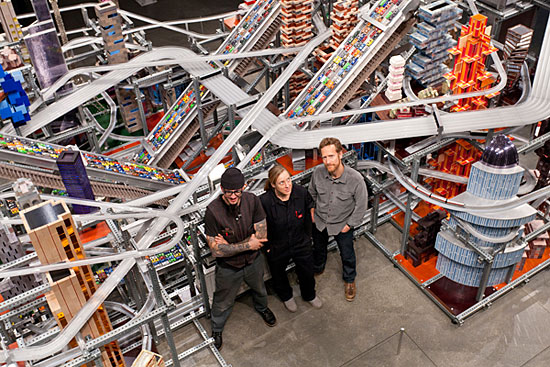
Many helped build Burden's city, including Rich Sandomeno, Alison Walker and leader Zak Cook. Photo © 2012 Museum Associates/LACMA
Chris Burden’s vast, new miniature skyline may have been one artist’s urban vision, but behind the scenes, it took a village to build “Metropolis II”.
“It was a long process—almost five years—and it took a lot of people,” says the L.A. artist on a recent morning at LACMA, straining to be heard over the din of his creation. The idea, he says, was to evoke the energy of a modern city; around him 4,400 tiny toy wheels on 1,100 toy cars whoosh around an elaborate thicket of toy skyscrapers at up to 240 scale miles per hour.
The room-sized piece, opening to the public January 14, is on long-term loan to the museum from its owner, LACMA trustee Nicolas Berggruen. A big hit in sneak peeks last month, it will be available for viewing anytime, but will only operate Fridays through Sundays, with a special showing on the Martin Luther King, Jr. holiday.
Situated just a short walk from Burden’s iconic “Urban Light,” it is mesmerizing and frenetic, a singular vision of a way of life familiar to every visitor with a car in the parking garage of the museum. But Zak Cook, Burden’s lead engineer, says as many as eight people at a time were assigned to the project, working under the artist’s watchful eye in his rural studio in Topanga.
“In all,” he says, “probably 14 people had a hand in it.”
Hiring crews of assistants isn’t unusual for successful artists, who often need extra hands and special expertise to execute large-scale ideas. “It doesn’t take away from the fact that it’s Chris’ work,” Cook notes. “The work couldn’t exist without Chris. It could exist without me.”
Burden’s crew, like the piece, reflected Southern California: There were two special-effects artists and two college-level art instructors, a maker of artisan snowboards, woodworkers, ceramicists and assorted masters of fine arts from UC Riverside and UCLA. One of the craftsmen on the prototype was the lead guitarist in the L.A.-based band “Dengue Fever.” Much of the infrastructure and train wiring was done by a heavy diesel mechanic-turned-jewelry-designer who was a finalist last year on Lifetime Television’s “Project Accessory.”
Some laid the Plexiglas track. Some built the dreamlike skyscrapers. Some installed the intricate floors and platforms. UC Riverside MFA Alison Walker and the “Project Accessory” finalist Rich Sandomeno came to know the piece so well that LACMA has since hired them to operate and maintain “Metropolis II” and act as a sort of pit crew.
“It was supposed to be a 9-month job and I ended up working on it for three years,” joked Sandomeno. “But it’s been so great to work with Chris and Zak and all the other artists. Besides, he adds: “When I was a kid, I loved Hot Wheels. “
The combination of Burden’s vision and all that painstaking labor is as intricate and playfully serious as art gets—a vast, buzzing skyline that has been compared to New York, L.A., “The Jetsons” and the 1939 World’s Fair. In the course of an hour, the tiny vehicles whip around the thicket of fanciful high-rises a collective 100,000 times on 18 lanes of traffic.
“It’s a city of the past and a city of the future,” says Burden. “It’s a city of the past in the sense that the cars run free, and a city of the future in their speed.”
An earlier, much smaller, version, with only about 80 cars, was built in 2004 for a Japanese museum, Burden says, “but they showed it for six months and then the museum changed direction. “ After the piece was put into storage—“all that work and then nobody got to see it”—Burden decided to make another Metropolis that would be “bigger and better.”
“Metropolis II,” however, took on a life of its own, says Burden: “I think we finished right around the time of Carmageddon. Every building took three or four months, which, I think you could build a tract house in that time.”
Cook served as general contractor for Burden’s architectural direction, working out such not-so-minor details as how to make the cars move reliably. (After much trial-and-error, Cook invented a sturdy, yet invisible, electrically powered conveyance system that hauls the toy cars uphill with magnets, like a rollercoaster, then releases them.)
Burden guided the team closely, Cook says, but also welcomed their input. Many contributed ideas for the exquisite buildings, which the team gave informal names: “AzDec Plaza” was a half-Aztec, half-Deco extravaganza contributed by Walker. An octagonal black high rise with blue windows, built by painter and fellow MFA Greg Kozaki, was known as “DarkTower.” A beautiful blue-and-green glass tile skyscraper was dubbed “Linkous Tower” by Frank Diettinger, a mold-maker who had done special effects for films such as “Sleepy Hollow” and “Bride of Chucky”, and who wanted to honor deceased indie singer-songwriter Mark Linkous.
“Whoever built it got to name it,” says Cook, adding that there was one major exception. “There’s an Eiffel Tower-looking building made from erector set parts, with the uppermost narrow part kind of extended, and Chris named that one.”
“Yeah,” laughs Burden, “I call it ‘Viagra Tower’ because it’s too tall.”
Cook worked on the piece from its inception. Of all the team members, he acknowledges, he probably has the least artistic resume. The 42-year-old son of a former Time correspondent, he graduated from UCLA with a degree in geography and worked for several years in the consulting division of CALSTART, a Pasadena-based clean transportation consortium.
But after a trip to India in 2000, he says, he realized that he didn’t want to keep doing white papers on the environmental impact of ports and airports; he wanted to write fiction and children’s books.
In search of a day job, he got a call one day from a friend who worked for Burden’s wife and fellow artist Nancy Rubins; Burden needed someone to help restore his 1998 sculpture “Hell Gate”, a massive bridge made of erector set pieces. The friend knew that Cook had done construction work in college.
Learning on the job, Cook then went on to help Burden build several more major pieces, including Burden’s 2001 “Bateau de Guerre”, a massive battleship made of gas canisters, and his 2002 model of a British landmark, “Tyne Bridge”.
Burden jokes that Cook “was in charge of work-ethic.”
“He’s very precise and thorough,” says the artist. “I couldn’t have done this work without somebody like him.”
Cook says that now that “Metropolis II” is finished, he intends to return to his own pursuits, and maybe finally finish those children’s stories.
“Not that Chris and I would rule out working together again in the future, but, honestly, this is such a great note to go out on,” he says, watching from a balcony at LACMA as the traffic hums by in the city that he helped make.
“I don’t see how I could ever top this.”
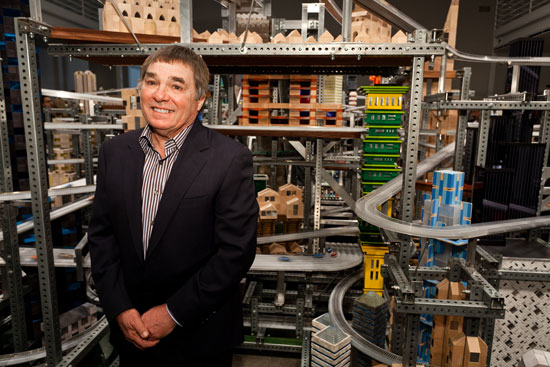
Chris Burden with his creation, created in his Topanga workshop. Photo © 2012 Museum Associates/LACMA
Posted 1/12/12
The Rock cometh—no, really
December 20, 2011
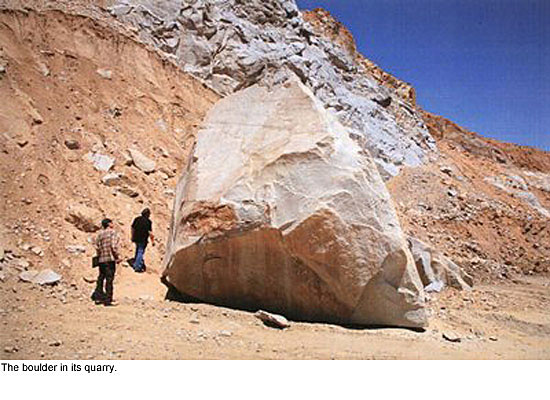 After months of postponements, the 340-ton boulder that the Los Angeles County Museum of Art has been awaiting since August has cleared what museum officials hope will be its final road blocks and is now scheduled to roll shortly after the first of the year.
After months of postponements, the 340-ton boulder that the Los Angeles County Museum of Art has been awaiting since August has cleared what museum officials hope will be its final road blocks and is now scheduled to roll shortly after the first of the year.
The route hasn’t changed, nor has the means of transit. But officials in the many municipalities through which the shrink-wrapped colossus will travel have at last all signed off on its passage, according to LACMA.
“Yes, it’s true,” laughs museum spokeswoman Miranda Carroll. “The permits are all secured now and all the cities have said okay. Everything is set.”
The boulder, destined to be the centerpiece in Michael Heizer’s massive new LACMA installation, has been waiting patiently at a Riverside quarry while officials in four counties tried to coordinate the bureaucratic details of its 100-mile move. The biggest snag involved the complexities of parking the rock on city streets during the daytime, when it will not be on the move.
Also complicating matters was that the transportation logistics turned out to be more complicated and time consuming than expected, forcing a process that normally takes more than a year into a span of six months. But with help from an assortment of players, including members of Supervisor Zev Yaroslavsky’s and Supervisor Don Knabe’s offices, LACMA officials have set a date. Just forgive them if they aren’t ready yet to go public with it.
“We’ll be getting the message out before the holidays, so people know what’s happening, but we just want to be absolutely certain,” says Carroll.
Stay tuned.
Posted 12/8/11
Dressed to thrill as LA Opera turns 25
October 26, 2011
A big birthday calls for some standout clothes. And let’s face it—when the honoree is an international superstar, the more over-the-top, the better.
As L.A. Opera celebrates its 25th year this month, its costume workshop in Little Tokyo is stitching away at full tilt. Creating exquisite outfits for the latest production, Gounod’s “Romeo et Juliette,” is just part of what’s going on.
Beyond the fittings and the finery, the workshop is shining brightly in its own supporting role, serving in effect as a gigantic walk-in closet for all the star-crossed lovers, murderous villains and phantasmagorical creatures who’ve thrilled L.A. opera audiences for the past quarter century.
Looking for enough boots to outfit a regiment? You’ve come to the right place.
A dragon gown with 25-foot train? They’ve got one.
Or perhaps a dressmaker’s mannequin shaped exactly like Plácido Domingo’s torso? Of course, along with the doublet and robe he wore when he starred in Verdi’s “Otello” in 1986.
That performance marked the beginning of opera as we know it in L.A.—a 25-year run that’s being celebrated at the company’s first ever open house at the Dorothy Chandler Pavilion in downtown Los Angeles on Saturday, November 5.
It’s all free—including performances and “Meet the Maestros” sessions featuring Domingo, the company’s general director, and its music director, James Conlon. (Advance reservations are recommended for those and some of the other parts of the day-long program, and a $1 handling fee applies; more information is here.)
In addition to performances of the children’s opera “The Prospector,” the open house also will feature a small but impressive sampling of the company’s vast costume collection, along with wigs, props and scenery.
Items selected to show off the costume workshop’s versatility and artistry include the Infanta’s costume from Zemlinsky’s “The Dwarf,” part of the company’s “Recovered Voices” series dedicated to rediscovering operas lost or neglected because of the Holocaust, and the costume worn by the title character in the Julie Taymor-directed “Grendel,” along with a spectacular dragon gown from the same work.
Special demonstrations at 10:30 a.m. and 3:30 p.m. will reveal some of the inside secrets of the craft.
For those who work there, the Alameda Street costume workshop has offered a front-row seat at L.A. Opera’s evolution.
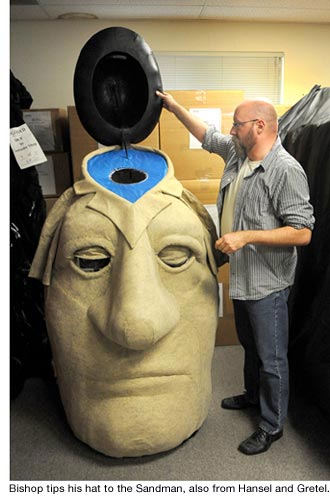 “It has changed dramatically,” said Greg White, the costume department manager who’s worked there 22 years. “It’s been fascinating watching the company grow over the years.”
“It has changed dramatically,” said Greg White, the costume department manager who’s worked there 22 years. “It’s been fascinating watching the company grow over the years.”
(This history on the company’s website charts some of the memorable moments, including the role of founding general director Peter Hemmings, the triumphs of the Domingo era and Conlon’s arrival in 2006.)
On a recent afternoon, White and senior draper John Bishop were able to point out some of the wearable souvenirs of L.A.’s operatic history as they walked through the two-story workshop/warehouse.
A stroll to what’s known in-house as the “diva rack” turns up Domingo’s duds from “Otello,” “Carmen” and “Samson & Delilah,” as well as costumes worn by Kiri Te Kanawa in “Vanessa.”
Not too far away is Frederica von Stade’s gown from “Grand Duchess.”
Costumes from last year’s ambitious staging of the operas in Wagner’s Ring Cycle are zipped into rows of oversized and carefully labeled fabric cases on the second floor. (But three costumes for Loge—the trickster fire god from “Das Rheingold” and “Siegfried”—remain in full view at the end of the hall.)
Sometimes the job requires finding a delicate balance between the costume designer’s vision and the performers’ preferences and physiques.
“On projects like The Ring, everybody has their opinion. Thankfully, with The Ring, most of the singers realized that vanity had no place in it,” Bishop said. “Most of the singers learned to roll with it.”
Some of the costumes have become workshop favorites, like the centaur-like creature nicknamed “Ralphie,” who appeared in “Hansel and Gretel.”
Others are remembered more as technical challenges that had to be wrestled into submission—like those colorful but architecturally demanding velvet coats from “Der Rosenkavalier.”
No matter how demanding the workday—including a recent marathon fitting session involving hundreds of costumes that had to be “planned like a military exercise”—there’s a pride in playing a pivotal role in every production.
“We’re certainly part of the storytelling,” Bishop said. “You will find everybody here is in love with what they do.”
Earlier this month, one of the workshop’s periodic public costume sales helped clear out some of the excess inventory. “All of it helps because it fills up so quickly back here,” White said. “We tend to be rather packrat-ish.”
While customers at the sale may have picked up some spectacular trick-or-treating ensembles—including someone who paid $2,500 for a get-up from “The Fly”—Halloween remains a little ho-hum for those who have turned costuming into high art.
“It’s a busman’s holiday in my book,” Bishop said.
Posted 10/26/11
Photos by Scott Harms/Los Angeles County
Posted 10/26/11
Where’s The Rock?
October 13, 2011
For months, Los Angeles art fans have anticipated the arrival of the 340-ton boulder that will be the centerpiece of Michael Heizer’s massive new installation at the Los Angeles County Museum of Art.
The Rock, as its minders have come to call the massive hunk of granite, was supposed to roll to Los Angeles in August from the Riverside-area quarry where, since 2005, it has been patiently waiting. The slow-speed odyssey, on the bed of a special truck, is expected to be almost as epic as the artwork, when it is finally completed.
Now, after many false starts and much speculation, a route has been finalized (click here for a map) and The Rock has a new date of departure—October 25, according to LACMA Director of Communications Miranda Carroll and the company orchestrating the move, Portland-based Emmert International.
So what’s been the holdup?
“Well,” jokes Carroll, quoting LACMA associate vice president John Bowsher, “you can’t hurry art.”
The more detailed explanation is that it’s not easy to transport a hunk of stone the size of a 2-story granite teardrop along more than 100 miles of urban surface streets and through the bureaucracies of four counties and more than a half-dozen municipalities.
Just assembling the transporter has been time-consuming. Custom built to The Rock’s dimensions, the special 2-truck contraption, whose segmented design has been compared to a caterpillar, has had to be assembled at the quarry, where the mover’s crews have tested and retested it.
Emmert specializes in transporting buildings, transformers, satellites and other massive objects, but unlike a piece of equipment, The Rock cannot be cut into components or easily strapped down.
Its weight, combined with its transport system, will total 1,210,300 pounds, says Emmert’s director of operations, Mark Albrecht. And because it is not just a boulder but part of an artwork, it must arrive at LACMA intact—no chips, no scratches.
So part of the time has been consumed in arranging the transporter’s complex system of tires and axles so that The Rock is secure and the weight is spread safely. Albrecht says each axle line will carry about 49,000 pounds, less than the weight spread of a standard tractor-trailer, and The Rock will be nestled on a special sling atop them.
“The thing fell off a 400-foot cliff when they blasted it out of the quarry, so I don’t think we can hurt it,” jokes Albrecht. “But we’re still handling it with kid gloves.”
Albrecht says preventing the rock from taking out traffic signals and low-hanging wires has been a major undertaking. He and his crews have had to coordinate with nearly 100 utilities in multiple jurisdictions to lift power lines, remove trees and get other obstacles out of The Rock’s path as it moves.
“Verizon alone has six or seven different areas,” says Albrecht. “The cable companies each have a bunch. And they don’t group up very well.”
Timing also has ramped up the degree of difficulty, says Albrecht, noting that this move is actually considered a rush job in the heavy-haul industry. Glitches are inevitable; bureaucracies are slow. Already, he says, the route has been adjusted three times to avoid roads and bridges that turned out to be weaker than expected.
“When you’re moving something this big, you usually have a year or year and a half lead time to work the permits, but we were just awarded the project in April,” Albrecht says.
The most recent snag has been a hardy Los Angeles perennial—parking. The Rock can only travel slowly and at night. The trip will require eight daylong stops in eight jurisdictions. “The problem is, where do you park something that long and that big and that heavy?” asks LACMA’s Carroll.
Ordinary parking lots aren’t an option, Albrecht says; the transporter is so wide and low-slung that just getting in and out would take six hours. That, in turn, would wreck the down-to-the-minute coordination with utilities whose wires will be cleared and replaced as The Rock moves.
“The route we have can’t change,” Albrecht says, noting that various bridge and overpass constraints have now narrowed the path to a single option. And security is an issue—pulling over also raises the risk that vandals might get to the precious cargo.
So for all but one break (a gravel lot in Pomona that will be its first rest stop), The Rock must be parked somewhere wide, flat, accessible to vehicles, easy to guard and hard to get to for humans. In other words, Albrecht says, The Rock has to park in the middle of the road.
Four jurisdictions (Pomona, Rowland Heights, West Carson and the City of Los Angeles) gave the thumbs up to the one-day disruption in each spot. But Albrecht says local officials expressed reservations in the other four.
So this week’s challenge was persuading Chino Hills, La Mirada, Lakewood and Long Beach that rush hour traffic could be funneled around a boulder, a 20-foot-wide transporter, an 8- to 10-man CHP escort and a flag crew, says Albrecht:
“All we need is someone to say, ‘Okay, we’ll allow it this one time.’”
By Thursday, the cities were mostly on board, and Albrecht was optimistic that The Rock will make it to its designated spot on the North Lawn of the Resnick Pavilion in time for the installation’s scheduled November opening.
There, the boulder will be placed atop the 465-foot-long concrete trench that makes up the other half of the artwork. The half-built trench will be finished, and when the artwork, called Levitated Mass, is finally completed, viewers will be able to walk into the trench and pass under the boulder—an experience that will make The Rock appear to float.
The $5 million to $10 million cost of the project, including its transport, will be borne by corporate donors, such as Hanjin Shipping, and private donors, including a number of museum board members. The experience is expected to be extraordinary, when The Rock finally gets here.
Its estimated time of arrival is November 4, a few hours before sunrise. At least that’s the plan for now.
Posted 10/13/11
Updated 10/25/11:
Newton wasn’t kidding with that stuff about an object at rest wanting to stay put. The Rock’s moving date has been moved again.
Just when it seemed a firm date had been set for the boulder in Michael Heizer’s “Levitated Mass” to be moved from its Riverside quarry, those parking difficulties with the various cities on the route flared up again last week.
“We’ve pushed it back at least week for now,” says Mark Albrecht of Emmert International, the heavy haul transporter handling the move for LACMA. This week’s sticking points: Lakewood and Diamond Bar.
The cities are balking at having such a large load on their roadways, Albrecht says, but the only feasible route to the museum is the one that has already been worked out. He says the cities have no need to worry—the route is more than sturdy enough to handle the cargo, but the permitting is being negotiated in a fraction of the time it usually takes to plan a move this large and complicated.
Talks continue, with more meetings scheduled for this week. Here’s hoping that everyone involved sounds like the opposite of these trick-or-treaters by Halloween.
Get a jump on “Pacific Standard Time”
August 31, 2011
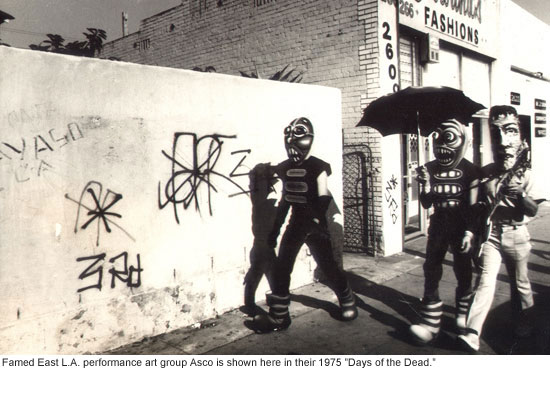 It’s going to be a big, big autumn for art in Los Angeles. In fact, a few places are already offering a sneak peak at the season’s most massive undertaking—“Pacific Standard Time.”
It’s going to be a big, big autumn for art in Los Angeles. In fact, a few places are already offering a sneak peak at the season’s most massive undertaking—“Pacific Standard Time.”
More than 60 cultural institutions and 60 galleries across Southern California will be joining forces in coming weeks to jointly tell the story of L.A.’s rise on the post-World War II art scene. The collaboration—its full name is “Pacific Standard Time: Art in L.A. 1945-1980”—will offer an unprecedented panorama of West Coast art and design.
The initiative was launched about ten years ago after local curators and artists became concerned that important L.A. work was not being appropriately preserved and archived.
“Many of the key figures were getting up in years, [and] their papers were being dispersed,” says Andrew Perchuk, deputy director of the Getty Research Institute. With nearly $10 million in grants from the Getty Foundation, a plan was launched to not only recapture an era, but also share its back story.
What emerged was the mother of all group shows.
“Initially, we thought there would be four or five related exhibitions, but then it just started snowballing,” says Rani Singh, co-curator of the Getty Center’s own exhibition, “Pacific Standard Time: Crosscurrents in LA Painting and Sculpture, 1950-1970,” which opens October 1.
That’s the official kickoff date for the “Pacific Standard Time” extravaganza, whose highpoints will include exhibitions featuring such greats as Ed Ruscha, Lita Albuquerque, Betye Saar, Henry Takemoto, David Hockney and Judy Chicago, as well as the first major study of California midcentury modern design.
Unofficially, however, dozens of exhibitions are scheduled to open early, with several key shows welcoming the public as soon as this week.
Among them: the first public showing in the United States of Edward Kienholz’s “Five Car Stud (1969-72),” and the first retrospective of the work of the legendary East L.A. underground arts collective, Asco.
Both of those exhibitions open Sunday, September 4, at the Los Angeles County Museum of Art, under the Pacific Standard Time banner. But LACMA is just one of many places offering a first taste of L.A.’s incoming autumn of art.
Here’s an early “Pacific Standard Time” sampler for this weekend:
- “California Art: Selections from the Frederick R. Weisman Art Foundation” has been open
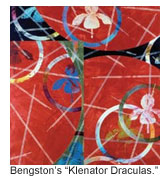 since August 27 at the Frederick R. Weisman Museum of Art near the Malibu campus of Pepperdine University. Weisman was an early patron and friend of L.A. artists and his collection features such now-renowned names as Ed Ruscha and Robert Irwin. The show features pieces by those artists and others whose work went on to become almost synonymous with art in L.A .
since August 27 at the Frederick R. Weisman Museum of Art near the Malibu campus of Pepperdine University. Weisman was an early patron and friend of L.A. artists and his collection features such now-renowned names as Ed Ruscha and Robert Irwin. The show features pieces by those artists and others whose work went on to become almost synonymous with art in L.A .
- “It Happened at Pomona: Art at the Edge of Los Angeles, 1969-1973, Part 1: Hal Glicksman at Pomona.” This show, at the Claremont liberal arts college that produced Chris Burden, has been open since August 30 at the Pomona College Museum of Art. Glicksman was a pioneering curator during the late 1960s and early 1970s, and his guidance shaped a generation of L.A. artists. The first of three “Pacific Standard Time” exhibitions at the museum, the Glicksman show features such important artists as Judy Chicago, Michael Asher and Lewis Baltz.
- Edward Kienholz’s “Five Car Stud (1969–72)” was among the artist’s last works in Los Angeles before he left to live between Idaho and
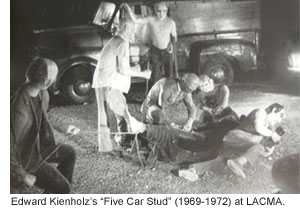 Berlin. It remains one of his most disturbing pieces to this day. A devastating tableau in a darkened room around a dirt patch, it depicts a black man being pinned down in a circle of headlights and castrated by white attackers while a white woman vomits in his pickup. Acquired by a Japanese collector shortly after a its only public showing (in Europe), it remained in storage until 2007, when it was sent for restoration to Kienholz’ widow, artist Nancy Reddin Kienholz. Its September 4 opening at LACMA, 17 years after Kienholz’ death, will mark the piece’s American public debut.
Berlin. It remains one of his most disturbing pieces to this day. A devastating tableau in a darkened room around a dirt patch, it depicts a black man being pinned down in a circle of headlights and castrated by white attackers while a white woman vomits in his pickup. Acquired by a Japanese collector shortly after a its only public showing (in Europe), it remained in storage until 2007, when it was sent for restoration to Kienholz’ widow, artist Nancy Reddin Kienholz. Its September 4 opening at LACMA, 17 years after Kienholz’ death, will mark the piece’s American public debut.
- “Asco: Elite of the Obscure, A Retrospective, 1972–1987 “ is the first retrospective of a L.A.’s seminal 1970s Chicano arts collective, now individually famous as Gronk, Harry Gamboa, Jr., Willie Herrón and Patssi Valdez. Inspired by influences that ranged from the Chicano rights movement to Dada, the four spent several years inciting happenings and doing performance art on the streets of East L.A., making themselves legendary in the city’s avant-garde underground long before anyone heard of guerrilla art or flash mobs. (Click here for a video of the L.A. artist Gronk recalling Asco’s style and history.) Today, a generation of young L.A. artists credit them as an influence.
- “Maria Nordman, Filmroom: Smoke, 1967–Present” is also opening September 4 at LACMA. Light—particularly the light in L.A.—is one of the great recurring themes in the “Pacific Standard Time” shows. Nordman began making her light-filled films and installations in the mid-1960s; this film was made in 1967 without a script on a beach in Malibu. It features two actors, but the sun and the Pacific Ocean are co-stars, the artist has said.
Posted 8/31/11
A “Great Wall” becomes even greater
August 30, 2011
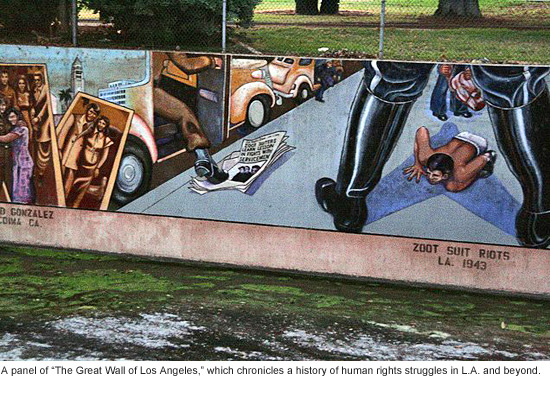 Every city has its hidden treasures. Take “The Great Wall of Los Angeles”.
Every city has its hidden treasures. Take “The Great Wall of Los Angeles”.
More than three decades old and 13 feet high, it unfurls like a vibrant tattoo for nearly a half-mile, recounting the history of human struggle and achievement along a concrete retaining wall in the Tujunga Flood Control Channel.
Flanked by a narrow park, it’s easy to miss what’s believed to be the longest mural on the planet. And yet it is this singular work—painted by hundreds of hands in the course of five summers—that launched Los Angeles’ reputation as the world’s mural capital.
Despite such rich origins, few public artworks have had to endure so many indignities. It’s been soiled by car exhaust, corroded by smog, bleached by fertilizer runoff and baked by the relentless sun of the San Fernando Valley. What’s more, political crosscurrents over the decades have generally put the kibosh on obvious possibilities for expanding the project, even as its once radical-seeming material—from the sins of the Spanish missionaries to the Japanese internment—has crossed into the historical mainstream.
“One would think it would have completely disappeared by now, given all it’s gone through,” marvels Judy Baca, the Watts-born activist, artist and UCLA professor whose vision has, since 1976, been the guiding light behind the project. “But what’s remarkable is how much of it is still there.”
Los Angeles has more than 3,000 murals, and their upkeep has been an ongoing civic battle. But next month will bring good news from “The Great Wall.”
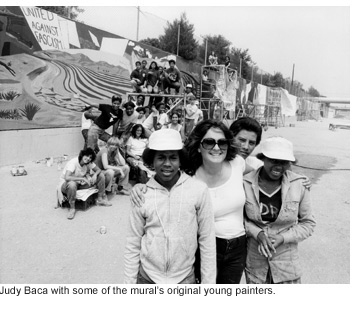 For the past three years, Baca and a crew of artists, volunteers and interns have been painstakingly restoring the artwork. In mid-September, the project is expected to be finished. A ribbon-cutting and celebration are being planned for September 17 at the park near the wall, which lies between Burbank Boulevard and Oxnard Street off Coldwater Canyon Avenue. (Click here for driving directions.)
For the past three years, Baca and a crew of artists, volunteers and interns have been painstakingly restoring the artwork. In mid-September, the project is expected to be finished. A ribbon-cutting and celebration are being planned for September 17 at the park near the wall, which lies between Burbank Boulevard and Oxnard Street off Coldwater Canyon Avenue. (Click here for driving directions.)
After that, Baca says, signage, lighting and a solar-lit “green” bridge with interpretive stations will be added, the better to see and understand the monument to L.A.’s multi-cultural history.
The entire $2.1 million improvement—spearheaded by the Venice-based Social and Public Art Resource Center (SPARC), with funding and assistance from the City of Los Angeles, L.A. County, the California Cultural and Historical Endowment, the Rockefeller and Ford foundations, the Santa Monica Mountains Conservancy, Supervisor Zev Yaroslavsky’s office, and others—should be finished late next year.
That, in turn, will set the stage for a fundraising drive to finish the next four decades of the mural (it now stops in the 1950s) using already-designed sketches that will take the narrative through the Vietnam War and the Los Angeles riots up to the 21st century.
For Baca, now an iconic figure on the Los Angeles art scene, the restoration is both a personal and civic milestone. A one-time high school art teacher in the San Fernando Valley, she has spent the better part of her life as a fiery advocate for public art.
As a summer art teacher in 1970 for the City of Los Angeles, she organized rival gang members in East Los Angeles to paint “Mi Abuelita,” a mural of a grandmother with outstretched arms that for many years was a Hollenbeck Park landmark. The project landed Baca a job as the head of a citywide mural program manned by at-risk teenagers, and led from there to the creation of SPARC, the nonprofit community arts organization.
“The Great Wall,” commissioned by the U.S. Army Corps of Engineers at the behest of the L.A. County Flood Control District to help improve the area around the Tujunga Wash, was SPARC’s first project. Since then, SPARC, for which Baca is artistic director, has produced hundreds of murals throughout the city, commissioning hundreds of artists and training thousands of youth apprentices.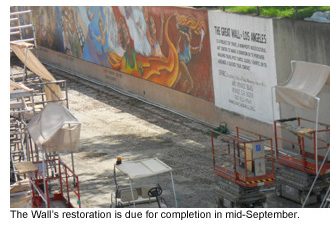
More than 400 at-risk youths, along with scores of artists and historians and hundreds of community members, worked on “The Great Wall” between 1976 and 1984, when painting stopped due to rising costs and safety concerns and the changing political climate during the Reagan Era. Many of those who worked on it found the experience to be life-altering, as this video recounts.
Although the mural’s initial segments were designed by at least 10 artists, each taking a different historical period, it was Baca who created the overall aesthetic beginning with the 1920s mural panel. When the “Great Wall” was started, she was 30. By the time she and her crews celebrate its restoration, she’ll be a week shy of 65. Time, she laughs, has taken a toll on the artist as well as the art.
“We have a funny thing going on down there,” she says of the restoration. “We have the senior citizens, who aren’t body-agile but have great hands, and then we have the younger ones, whose hands aren’t as adept but who have the bodies to continue. We’re transferring knowledge and teaching them to collaborate—it’s a very important moment.”
But, she adds: “I think this will be my last year on the channel. It’s incredibly physically demanding. I think it’s time for the younger people to take over.”
Meanwhile, she says, she’s had the privilege of revisiting a formative period in her life.
“I’m having these dialogues with my younger self on a daily basis,” she says. Simple decisions—what color to use in restoring the image of an Okie, or whether to underscore the Madonna-and-child subtext of a migrant worker holding a baby—“give me this visual of who I was when I painted it,” Baca says.
“That Judy was working with this incredible passion. She had boundless energy and this incredible willingness to put it all out there. This Judy, at 65, would probably say, ‘This is way too hard.’”
If she had to do it all over again, she says wouldn’t change a thing.
Although the project, in retrospect, was an “incredible marathon” and a massive undertaking, she says, it also was “a great labor of love”—and of youthful idealism.
“I may have much more wisdom now, but that girl was limitless,” says Baca. “She was limitless.”
Pedaling art in Santa Monica
August 18, 2011
There’s art, there’s entertainment, there’s exercise, there’s environmentalism. And sometimes they all come together in one magical day that just happens to involve bicycle bells, flamenco dancing and, yes, food trucks.
That day is Sunday. The place is Santa Monica. And the ride of choice is (you guessed it) the bicycle.
The Santa Monica Museum of Art rolls out “Cause for Creativity: Tour da Arts, Vol. 3,” uniting cycling and art communities for an afternoon of fun that won’t leave a big carbon footprint. Visual art, spoken word, live music and dance are all in the offing during a scenic bicycle tour of the city.
Bikers will meet at the museum at high noon for check-in and a Cycling Mini-fest, where event partners will provide services, education and entertainment. Attendees can tune up their bikes with Bikerowave, get current on bike advocacy with groups like the Los Angeles County Bicycle Coalition and check out the hottest in bike riding fashion (it’s not all spandex). It’s also a good time to check out the Museum’s exhibitions, or add a little “bling” to your bike at the Spoke Card Art Workshop ($5 for nonmembers.)
Every cyclist will be given a free bicycle bell for the ride, and free bike bags will be handed out to the first 150 people who show up.
The tour itself embarks at 2:30 p.m., and heads to The Broad Stage for music and a world dance performance from Global Motion and Synapse Contemporary Dance Ensemble of Santa Monica College. The ensemble is an all-student dance group, choreographed by faculty, which has performed in venues across the city, country and world. It will present five contemporary global dance works, including flamenco dancing and a Polynesian dance to the world music hit “Tutuki.”
Next stop is Santa Monica City Hall, where cyclists join a free public performance of “Jazz on the Lawn” with the Electones, sponsored by L.A. County Supervisor Zev Yaroslavsky as part of the county Arts Commission’s free concert series. And since riders are already there on pollution-free pedal power, they can show their depth of commitment to the environment by grabbing a free reusable shopping bag, courtesy of the Santa Monica Office of Sustainability and the Environment’s “Bring Your Bag” initiative.
At 6 p.m. the caravan returns to the museum for a sonorous and collaborative finale with the “Bicycle Bell Ensemble.” Riders join professional musicians, chiming in time to create a bike bell orchestra (practice sessions are earlier at the Mini-fest).
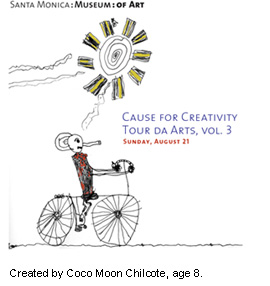 The total distance of the ride is about 7 miles. Healthy snacks and drinks donated by a variety of vendors will be provided at each stop. For something more substantial, mobile food vendors Mandolin Grille, L.A. Snowie, and Dosa Truck will be stationed at the museum to sell their gourmet concoctions.
The total distance of the ride is about 7 miles. Healthy snacks and drinks donated by a variety of vendors will be provided at each stop. For something more substantial, mobile food vendors Mandolin Grille, L.A. Snowie, and Dosa Truck will be stationed at the museum to sell their gourmet concoctions.
The event, the third of its kind, is the latest collaboration between Santa Monica Museum of Art and Cyclists Inciting Change thru Live Exchange (CICLE), which manages ride logistics to ensure the safety of the group. Last year’s “Tour da Arts” attracted about 400 riders. Elizabeth Pezza, the museum’s assistant director of communications, says that she expects even more this time around.
“It’s one of the largest organized rides on the Westside, and it’s the only one I know of that has organized events at each stop,” Pezza said.
Asuka Hisa, the event organizer and the museum’s director of education, first conceived of bringing people together in this way four years ago, when she was “feeling the cycling vibe in the city of L.A.” The event became part of the museum’s “Cause for Creativity” program, which aims to raise social awareness through engagement with the arts. Hisa relied on previous work experience in planning the event.
“I drew on my experience being an arts commissioner with the City of Santa Monica,” she said. “This was a great way to broaden the audience and engage the residents in the rich cultural resources of the city. It’s been so beneficial for everybody.”
The museum also got the public involved in creating signature graphics for the event, requesting submissions from kids for a “Bike Critter Art Contest” in July. Word of the contest spread quickly on Facebook and Twitter, and hundreds of submissions came from as far away as China and South America. A jury of artists made the final call, choosing a mouse-like creature by 8-year-old Coco Moon Chilcote of Philo, CA.
And the creativity isn’t limited to the artists. Some of the participating cyclists are expected to arrive in costume atop wacky custom rides.
The tour takes place this Sunday, August 21. Online registration is highly recommended if you want to join in. Directions to the museum and further details about the event (there are some basic safety requirements) can be found on its website. And if you want to see what last year’s ride was like, check out this video.
Posted 8/18/11




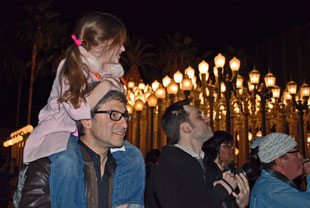

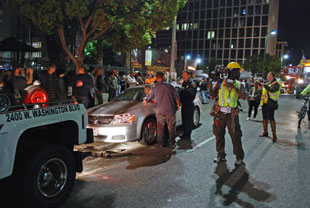
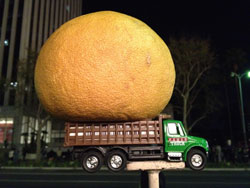
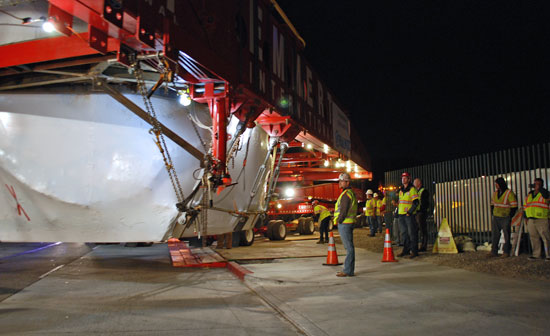
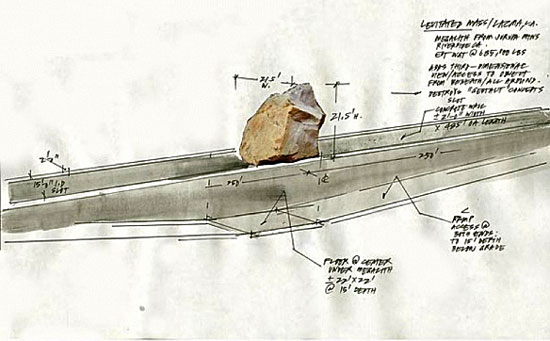
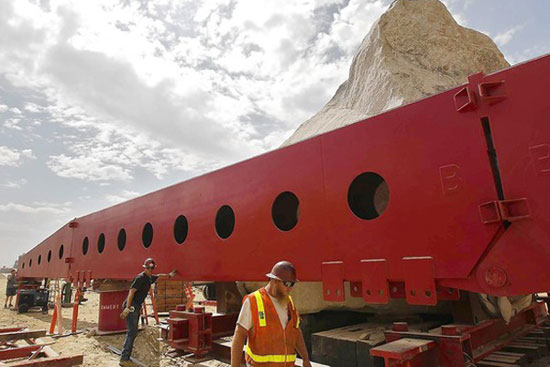

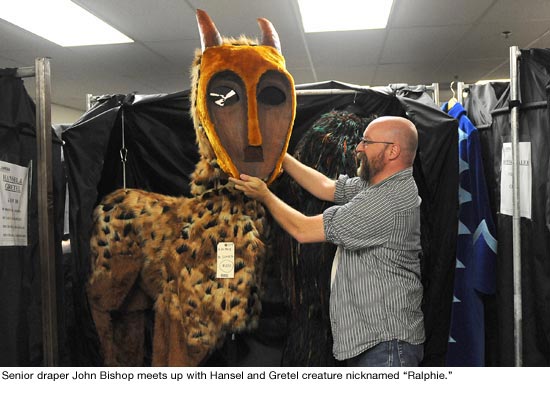










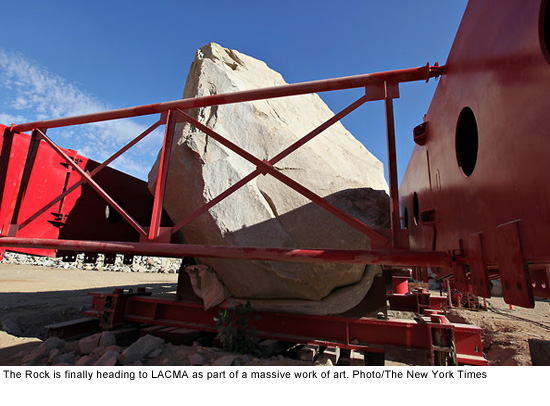
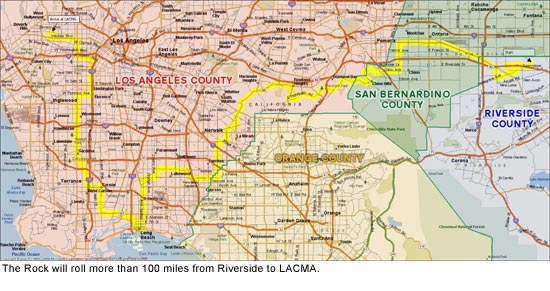
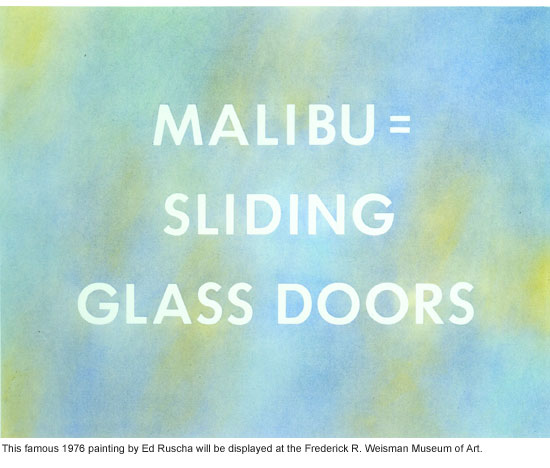
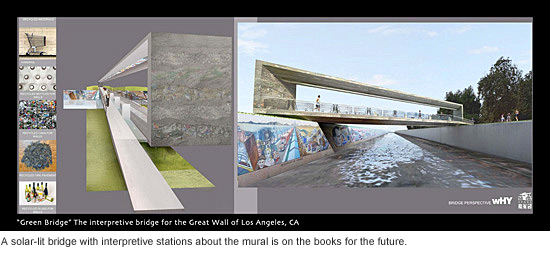
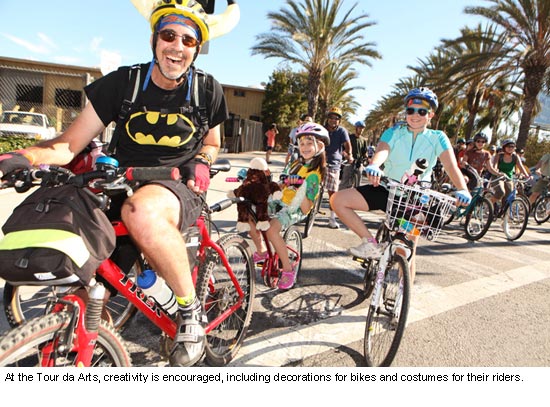









 405 bridge work causes a stink
405 bridge work causes a stink